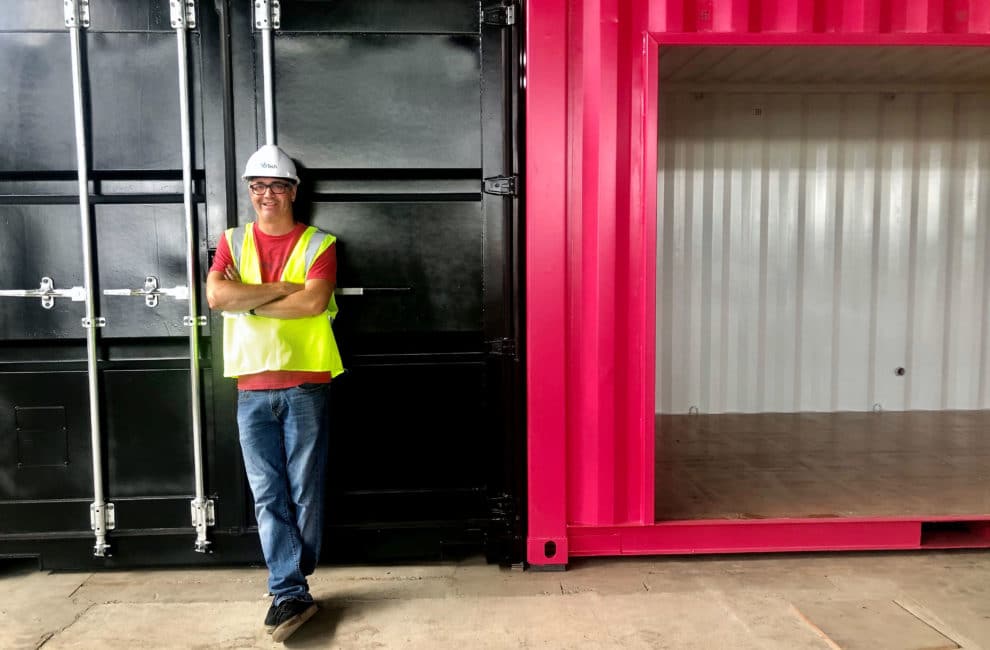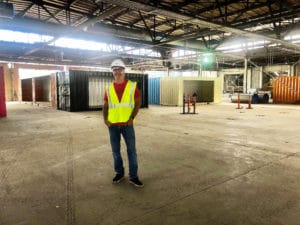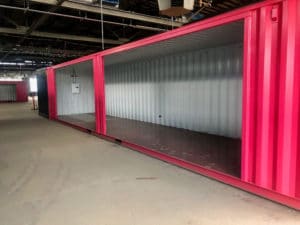Out of the Box

Craig Baker at AMP Suzanne Krowiak
Everybody wants the scoop on those brightly colored shipping containers chef Craig Baker has been teasing on social media. What’s in them? Where are they going? Why are giant pink metal boxes so much fun to look at?
While the rest of us engage in furious speculation, Baker has been quietly brainstorming with architects, designing plug-and-play restaurant kitchens, collaborating on mentorship programs, and recruiting successful food businesses to expand their locations to AMP, an artisan food marketplace on the near west side. Part of the 16 Tech Innovation District business and residential hub surrounded on all sides by the White River, Fall Creek, and Indiana Avenue, AMP occupies a cavernous, 40,000-square-foot building formerly occupied by the Indianapolis Water Company. What used to be a garage filled with service trucks now bustles with construction crews maneuvering forklifts around those aforementioned shipping containers. The project looks like a life-size Lego set being put together before our very eyes.
So what is AMP? It’s equal parts food hall, grocery hub, performance space, restaurant bootcamp, and community center. “I imagine a European market surrounded by some food outlets and a beer garden,” says Baker. “So it’s basically a living room for Indianapolis.”
Baker knows the food biz well. He started his culinary career with a popular bar and restaurant in Portland, Oregon, then relocated to Indiana where he was the chef and owner of places like The Local Eatery & Pub, Plow & Anchor, and Bent Rail. In recent years, he’s been busy with a private catering business and his restaurant consulting firm, Häiv Hospitality. Since being hired as a consultant by 16 Tech, these days you’re likely to find him in a hard hat and bright yellow construction vest, answering calls and texts as he maps out the best layout for his dream team of shipping container occupants: a butcher, fishmonger, coffee bar, flower shop, produce market, winery, and baker, just to name a handful. In addition to the shipping containers, there will be a 3000-square-foot full-service restaurant, a brewery with a beer garden, and a large stage for everything from live music to poetry readings. Not to mention a six-story parking deck right outside the door. “I’m trying to build a microeconomy inside of this venue,” says Baker. “If a restaurant needs bread, they can contact a baker on site. By the end of the year, there will be 250 apartments coming online in the district. There probably isn’t a grocery store within a mile from here, so it will be really convenient for the residents. They can buy a couple of steaks at the butcher and some vegetables from the produce vendor, grab some wine, and take it all home for dinner.”
Baker did a lot of research on food halls and markets across the country, citing Cleveland’s popular West Side Market and New York City’s Chelsea Market and Bryant Park as inspirations. “At Bryant Park everyone has their own little sheds, almost like something you see at Home Depot. And the AMP building is really big. The shipping containers were a way to give people individual space so they could make it their own and decorate it, rather than having a wide open food hall. They allow everyone to show their personality, kind of like Mr. Rogers’ Neighborhood.”
There are 15 total shipping containers inside the building one with a large stage extending out into the center of the building for live shows. The containers were acquired through InMod Construction in Fishers, which painted them, sanded and sealed the floors, and outfitted each one with its own power supply and water source.
But it’s not just the shipping containers and full service restaurant that will be serving the public. On the north side of the building, there are seven fully outfitted restaurant stalls that will serve as incubators for new businesses, with everything in place to launch a restaurant, except for the chef and food. Five of the seven stalls are already spoken for, and Baker says local foodies will recognize some of the names on the signs (which remain top secret for the moment). There’s also a pop-up space with a full kitchen that someone could rent for an event or use short term—say 30 days—to test out a new concept or build buzz for an opening.
On one side of the building there’s a large kitchen space that will operate as the home base for a culinary education program, where aspiring chefs and restaurateurs will be mentored for free, and they’ll run a “ghost kitchen” with an online menu available for home delivery. The first five trainees have already been accepted into the program, which Baker anticipates will last about six months. “I’ve been in this business for 25 years. The biggest problem I’ve seen is that people get excited, and they start sprinting before they can walk,” Baker says. “The emotions get ahead of them. This is going to help people be successful because it forces them to think through what they really want to do. What’s their business plan? What do they need to make it happen?”
While Baker is still signing contracts and can’t spill the beans on everyone who’s committed to a lease yet (as of this writing, he says he’s over 50-percent full), local baker Cindy Hawkins was one of the first on board, and is moving her flagship Circle City Sweets and its sister Circle City Boulangerie out of Indianapolis City Market and into one of the AMP container in early 2021. “Believe it or not, there’s more square footage in that shipping container than I have right now at the market,” says Hawkins, who plans to retain a presence at City Market with the businesses she and her husband Roger also own, Circle City Soups and Mile Square Coffee.
AMP is connected, via hallways and tunnels, to two other 16 Tech projects. One is the 1776 building, which is a business support center with a combination of coworking spaces, private offices, mentorship programs, and a soundproof room that can be used for projects like podcast recordings. The other is Machyne, a makerspace where membership gets people access to things like a woodshop, welding equipment, and 3-D printers. Dr. Alex Bandar is the founder and operator of Machyne. Bandar launched the Idea Foundry, the largest collaborative makerspace in the world, in Columbus, Ohio, in 2008. Having Machyne connected to AMP is one of the perks that appealed to Hawkins when she was weighing whether or not to move her bakery and retail space. “How fun is that?” she says. “If we have an idea for a baking mold, we can go in and say, Hey, we need a 3-D printer creation of this, and they can design it for us and produce it right there.”
For Baker, AMP is providing an opportunity to use his lifetime of experience in kitchens and education (he was a history teacher in his pre-chef life) to help Indy’s best small businesses grow, and provide a launch pad for those who have big culinary dreams but need support to take the next step. “The restaurant business is in my blood,” he says. “I’m still in the kitchen all the time for private events and clients. But I was in secondary education before all of this. And as fun as it is to design this space and think creatively about how to use it, I’m most excited about the coaching and mentoring part of the job.”
If all goes according to plan, AMP will open for business in January or February of next year.








